Electric heating radiators: main types, advantages and disadvantages of batteries
Stationary batteries do not always provide a comfortable temperature regime.In particularly cold winters it is necessary to use additional heat sources. A good option is electric heating radiators, which by and large only include oil batteries.
In practice, this group includes all electric heating devices equipped with fins - this design best distributes heat. In the article we presented, all types of heating electrical equipment are analyzed in detail. Reliable information will help you decide on the best option for you.
The content of the article:
Advantages of electrical appliances
There are several arguments in favor of electric batteries. They are easy to install and operate. Installing a mobile electric battery involves simply plugging it into an outlet and setting the modes. When installing a radiator on a wall, a bracket is sufficient.
Such a device can always be relocated to another location. To connect an electric battery, you do not need to order a project and obtain permission. This applies to all types of these devices, except in-floor ones.
Electric radiators are safe and environmentally friendly. Since their housing is sealed, harmful substances do not enter the surrounding atmosphere. Batteries powered from an outlet look aesthetically pleasing and will not spoil any interior.
The thermostat present in the design of the electric battery allows you to set the optimal temperature regime. By setting a certain temperature using a thermostat, overheating of the heating unit is prevented.
Some experts believe that manufacturers present electric oil batteries as innovative, ultra-economical heaters.

In fact, this is a regular oil-cooled radiator, distinguished by the presence of an aluminum housing and a digital indicator. In their opinion, this is simply a publicity stunt with the aim of raising their cost completely unjustifiably.
Types and types of electric radiators
The range of electric radiators, as well as their functionality, is very diverse. This group includes all heating devices equipped with fins, because This design best dissipates heat.
All existing electric radiators can be divided into two large groups: liquid devices and liquid-free ones.
Electric radiators are classified according to location and size:
- wall;
- ceiling;
- floor
As a variety, there are plinth, in-floor, glass, and ceramic appliances.
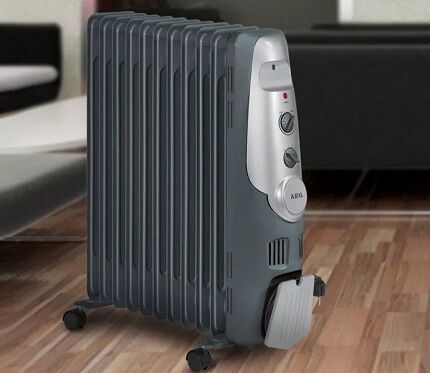
Based on their design, electric batteries are classified as follows:
- oil;
- fan heaters;
- infrared heaters.
Based on the type of heat emitted, electric heaters are divided into two groups. The first includes convectors - devices that supply heat through the movement of heated air masses.
The second group includes systems that transmit safe-spectrum IR radiation to objects within the device’s coverage area, after which the heated objects distribute it into the environment.
There are 2 versions of these heating devices: stationary and portable.
Electric batteries with coolant fluid
Batteries of this type are characterized by ease of execution with a small set of components. Heating occurs through tubular electric heater (TEH) low power - 300 - 500 W.
There are also more powerful elements. Heating elements are placed in an aqueous or oil medium, in some cases - in a non-freezing liquid.
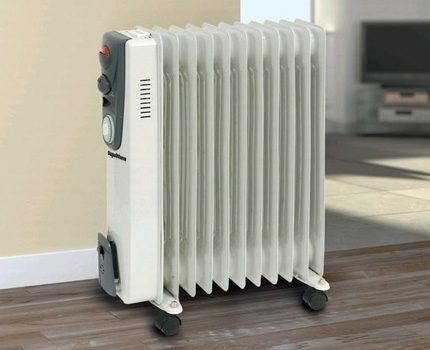
There are two models of liquid electric batteries on the market: hermetically sealed and open. In the latter case, coolant is added to the device if necessary.
The heating element heats the coolant to a certain temperature, which transfers the temperature to the metal body, which radiates the resulting heat into the room. The larger the heat-transfer surface, the better the air in the room warms up.
As a rule, electric batteries are aluminum.This material is more suitable than any other for the manufacture of heating devices, since it is lightweight and endowed with the necessary properties to withstand high temperatures.
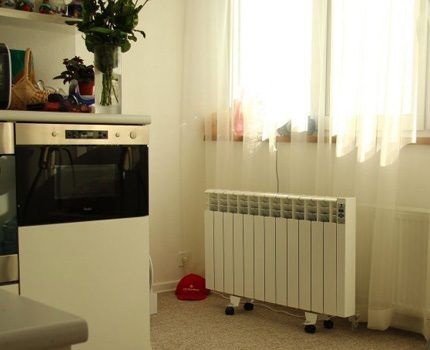
If the coolant in liquid electric batteries is a non-freezing liquid, they are well suited for rooms that are heated only periodically. Electric batteries, where mineral oil is used as a coolant, consume more electricity than radiators using distilled water.
This is explained by the fact that the oil has a higher density, therefore, it warms up with greater energy expenditure, but to a higher temperature. Criteria choosing an oil heater are detailed in this article, which we recommend reading.
Structurally, the electric battery consists of sections, an upper and lower collector. The heating element is placed in the lower collector. The design does not provide for the presence of open heating elements, so neither oxygen nor dust particles in the air are burned.
Radiators operate silently, but since the surface heats up to a high temperature, it is necessary to ensure that it does not come into contact with easily flammable objects.
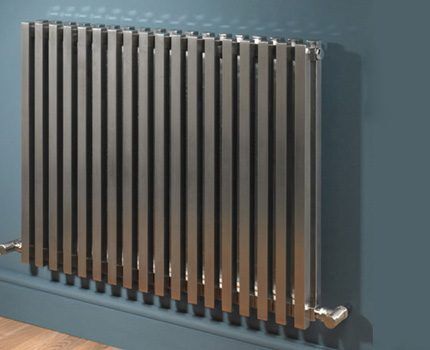
The best liquid electric batteries according to users include:
- DeLonghi GS 770715 – battery of 7 sections, designed for 15 m², with a thermostat, fan, with protection from both overheating and freezing;
- Mystery MH-7001 - radiator with three degrees of adjustment;
- ROLSEN ROH-D9 - nine-section battery equipped with a portable clothes dryer;
- Electrolux EOH/M-1157 - designed for a room up to 15 m².
In general, electric batteries used for heating are economical devices. When turned on, they use maximum power, but after heating the coolant to the required temperature, the thermostat turns off the heating element. These batteries are easy to install and manage.
Liquidless Electric Batteries
Dry or liquid-free electric batteries, compared to their liquid counterparts, have less mass and heat up faster.
There is no intermediate coolant here, so heat transfer occurs directly to the heat transfer surface from the heating element.Such radiators operate on the principle of convection, hence their more common name - electric convectors.

The air heated by the heating element, rushing upward, displaces an air mass with a lower temperature. That, in turn, passes through the body of the convector and repeats the movement according to the previous pattern.
In this case, the surface of the convector heats up, but the body temperature is not very high. Liquid-free electric heating devices are used only autonomously. The most popular models of liquid-free electric batteries include the SIRA Onice 1600. The radiator has 8 sections, a thermal power of 1.6 kW, and a built-in temperature controller.
Convectors are produced both wall-mounted and floor-mounted. A special group is baseboard electric batteries. While the installation of the first two modifications can be done without the involvement of specialists, the installation of the third type of electric batteries requires special knowledge and experience. Typically, the installation of such convectors is planned during the construction stage.
Trench electric convectors
Since radiators of this type are located in a recess in the floor, they are a hidden type of heating system, therefore, without taking up extra space, they quietly heat the room.
They are heated by creating a warm air curtain to block the penetration of cold air through the most vulnerable places in the room. The in-floor electric radiator operates on the principle of convective heating.
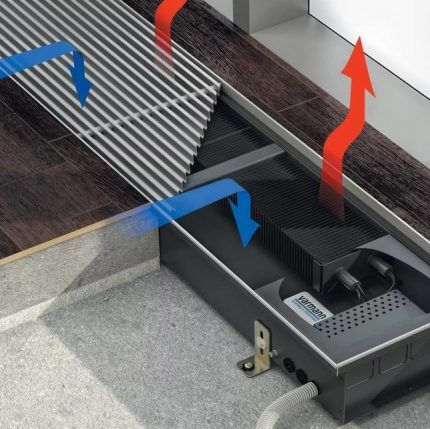
A heating element is inserted into the battery itself, and metal plates with good thermal conductivity - aluminum, copper, thin steel - are mounted on it. Sometimes metal is replaced with ceramics. This solution allows you to expand the heat transfer surface.
The body-box, at the bottom of which there is a heating element with a plate tail, resembles the letter U in outline. To prevent heat from escaping to the floor and to the sides, the body is insulated.
To regulate the thermal regime, a temperature sensor equipped with a microprocessor is built into the box. If a forced ventilation draft is not provided for an in-floor radiator, the height of the housing in which the battery is enclosed should not be less than 200 mm.
The structure is covered with a durable decorative metal grille that does not extend beyond the floor level and can support the weight of a person.
The throughput capacity of this enclosing structure is important, determined by the ratio of its total area to the total size of the slots. A sufficient volume of cold air masses and heat flows must pass through the grille.
More powerful electric radiators are equipped with additional fans to enhance convection properties. The height of the case in this case does not matter.
To reduce the noise from a running fan, it is mounted on vibration mounts with porous rubber inserts.The presence of a fan guarantees faster heating of the room and reduced electricity consumption.
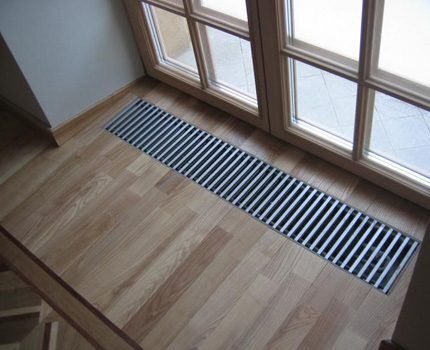
Electric batteries built into the floor have a number of positive qualities. The place for their installation can be determined in any part of the room, they take up virtually no space, and thanks to the large assortment of grilles, they fit well into any interior.
There are linear and roll gratings. The crossbars in linear gratings are both transverse and longitudinal, while in roll gratings they are only transverse.
The disadvantage of these heating devices is the complexity of installation and the cost, which is much higher than that of wall-mounted batteries. In rooms with a high ceiling - more than 3 m, they are not very effective, in addition, they contribute to the dispersion of dust throughout the room.
A type of electrical heating system at floor level is a heating baseboard:
Characteristics of infrared radiators
Infrared electric heaters are fundamentally different from other types of similar devices. Their task is to warm up objects located in their area of action.
This is realized through electromagnetic waves. Their radiation does not heat the air in the room, and the device itself remains cold. Heat is released into the environment by the heated environment.
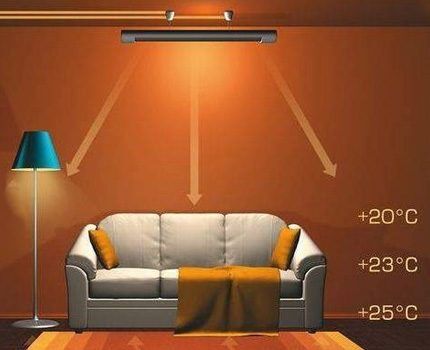
Based on the type of heating element, infrared radiators There are: heating elements, ceramic, carbon. The first type of heater consists of a metal body, an insulator, an anodized plate, foil and a heating element. The optimal thickness of the anodized layer is 0.025 mm, and the foil thickness is 0.012 mm.
Depending on the model, the power of the device varies from 0.8 to 3 kW. Adjust it manually or using a thermostat.
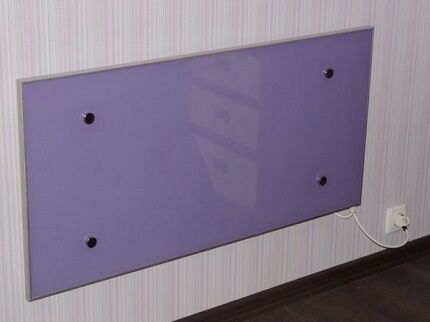
Ceramic heaters are available in three versions. They are wall-mounted, floor-mounted and table-mounted. The first ones are distinguished by their considerable dimensions and are visually similar to an air conditioner.
Floor models are the most popular.For safety reasons, they are equipped with special sensors that turn off the device if it overturns or overheats.
Tabletop appliances are often used outdoors. During operation, they rotate and effectively warm up objects and people that fall within the reach of infrared radiation.
The heating element in a carbon infrared heating device is carbon fiber enclosed in a vacuum quartz shell. Manufacturers claim that this fiber practically does not fail and can be used indefinitely. Only a quartz tube can fail if it breaks when dropped.
The most popular models of infrared heaters are:
- Polaris PMH 2095 is a powerful, practical device with a stylish design;
- Electrolux EIH/AG2-2000E is a floor-standing device that effectively maintains the temperature in a room up to 25 m²;
- Timberk TCH A5 1000 is a ceiling model, characterized by compact dimensions and easy settings;
- Hyundai H-HC1-18-UI572 is a device for wall or ceiling installation with many useful functions;
- NeoClima NC-CH-3000 is a compact heater with mechanical control.
Since infrared emitters are inertia-free, you can feel comfortable in the room within 15 minutes after connecting the device.
They do not emit any combustion products during operation, and there is no need for special ventilation for them. But if there is a ventilation system in the house, then they do not have any impact on its operation.
Rules for choosing an electric battery
The correct selection of an electrically powered battery involves taking into account the thermal power of the device. If you plan to use the heater as an additional one, no more than 80 W will be required to heat 1 m² of a room with a height of 2.6 m.

To heat a room of a specific area, a certain number of sections will be required. The rated power of one is 0.13 kW. Based on this parameter and the area of the room, it is easy to calculate the optimal number of sections.
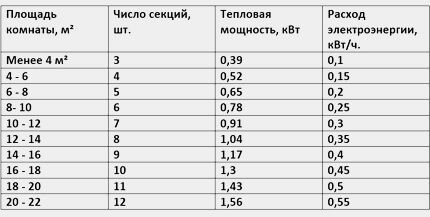
If a convective electric battery is the only type of heating, then a 10 m² room with a ceiling height of 2.6 m² will be heated to a comfortable temperature by a 1 kW heater. When the ceiling is higher than the specified value, the result should be increased by one and a half times.
This is an average calculation, to obtain more accurate data you need to take into account:
- the material from which the building's enclosing structures are constructed;
- the presence of a ventilation system and its type;
- type of device and its functionality;
- network parameters;
- temperature range requirements.
When choosing an electric battery from a certain price category, you should know that the price of the battery is largely influenced by the type of thermostat.A mechanical thermostat is half the price of an electronic one, but such savings are relative - the presence of an electronic thermostat allows you to save about 4% of electricity.
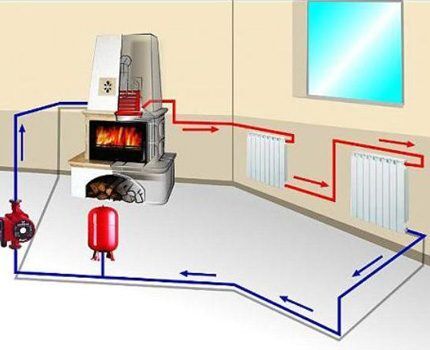
The choice also determines the location of the intended installation of the battery. The dimensions of the device and properties depend on it. If a special niche is provided for it, the battery should fit freely into this space.
The same condition must be met if the radiator is placed under a window opening. To install in a bathroom, you need a radiator that is protected from moisture. In order for the electric battery to work reliably, you should choose among models from well-known brands. When installing, you must comply with the requirements set out in the instructions.
For safety reasons, a gap of at least 0.5 cm is required between the battery placed in a permanent place and the wall, and the wire leading to the outlet should not come into contact with the heated surface.
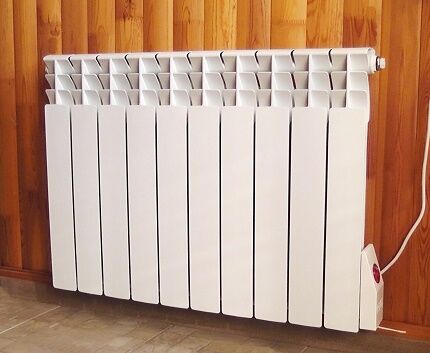
Installation of devices for which a plug is provided for commissioning does not require any preparatory measures.
This issue is more difficult to resolve when in order to connect several batteries and connect them into one system, you need to additionally run a cable.
A prerequisite is to include a protective switch of at least 30 A in the circuit, and the main core of the cable must have a cross-section corresponding to the sum of the powers of all batteries.This heating system can be controlled using a remote control.
Conclusions and useful video on the topic
The video will clearly show you how the electric radiator works:
Every year the range of electric radiators is updated. Not only their technical characteristics are changing for the better, but also their design.
In order to make the best choice, you need to analyze the available information and, based on this, decide which technical indicators are suitable for your specific case.
Please write your comments in the block form located below the text of the article. Tell us about how you chose an electric radiator for use in a country house, office or apartment. Share useful information, ask questions, post photos on the topic.




During a particularly cold winter, we installed these electric batteries in our office for additional heating. I don’t know, maybe they were just cheap, but they were of no use at all. It was possible to warm up only by placing this battery next to you, and the room did not get any warmer. Conventional heaters are better; at least they release warm air in a directed manner.
I have three floor-mounted oil radiators at home; the whole family has been using them for seven years now, waiting for the start of the heating season. They suit me with almost everything, except for two points. First, after connecting to the network, for about half an hour, they give off an unpleasant and quite strong smell. And secondly, there is a large consumption of electricity. But we must give them credit, they warm up rooms quickly and are easy to use.
All these heaters have only one drawback - when they are turned on, the meter starts spinning like crazy. In the winter we constantly turned on the oil heater in the nursery because it was cold. Then at one point I insulated the windows and there was no longer a need for it. The utility bill dropped by RUR 2,000.
Is it true that if an oil heater falls, it is no longer usable?
Hello. If the heater has been operating for a long time in this position, there is a risk of the coil burning out, however, in most cases, the models are equipped with tip-over protection. It is a myth that if it falls over, the device is unusable for use if it does not have significant mechanical damage, leaks or other defects.
Hello ! I need to decide which is better: gas heating or electric? What is more profitable?